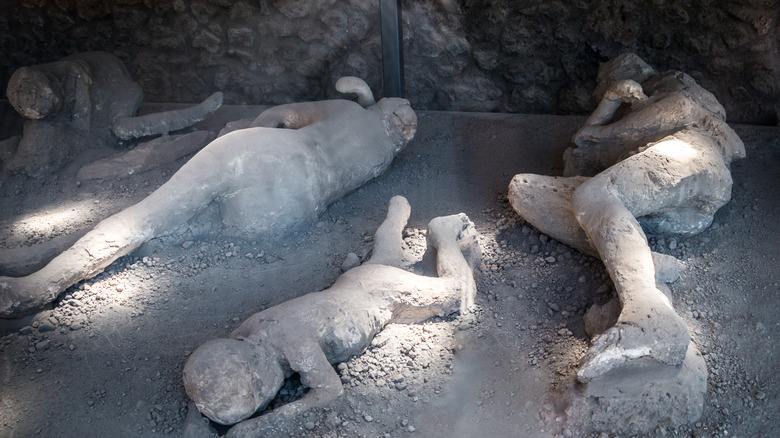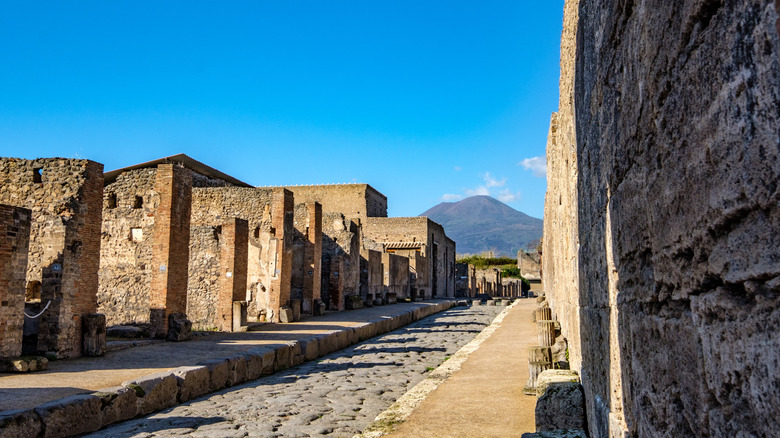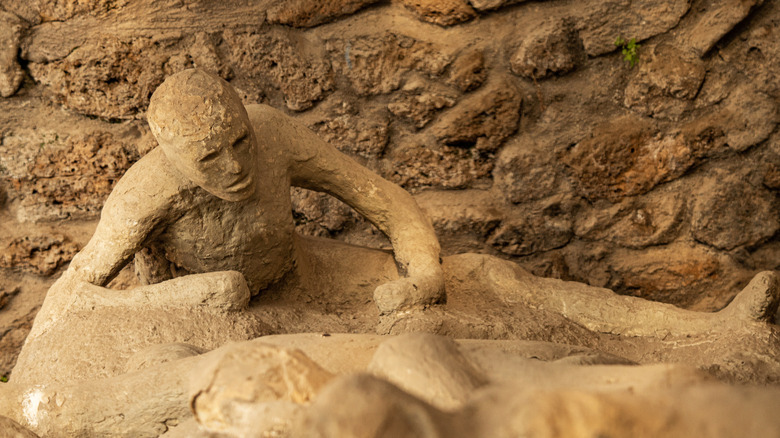Why You Can Still See Facial Expression On The Bodies Of Pompeii
The hot ash drained down the slopes of the volcano. Then came the burning, suffocating gases. The day was as dark as night. In August of the first century, Mount Vesuvius showered Pompeii with a deadly storm of debris followed by two days of heavy ash rains. It not only killed around 2,000 of its estimated 12,000 residents, but it also helped preserve them for all eternity. And it took the genius of an archeologist named Guiseppi Fiorelli to unlock the secret that lay buried under layers of ash and pumice for nearly 2,000 years.
In the ensuing centuries following the destruction of Pompeii, its victims' bodies slowly decayed — along with the fading memories of the catastrophe — under a layer of volcanic ash almost 20 feet deep, leaving only their skeletal remains. Then, in 1863, Fioreli perfected a means of preserving the remains of Mount Vesuvius' victims, which revealed one of the most disturbing aspects of Pompeii's destruction. He realized the hardened ash surrounding the skeletons where the soft tissues of the bodies had once been were akin to a sculptor's mould. After he'd perfected a special plaster, he poured it into the spaces and revealed the ancient Romans' final moments in startling detail.
The death and rebirth of Pompeii
Pompeii was once a thriving resort city by the sea on the Bay of Naples filled with well-appointed villas, public squares, artisan's shops, even fast food restaurants, just 5 miles from Mount Vesuvius. There had already been signs that the active volcano was getting ready to erupt, including a series of small earthquakes in the days before the tragedy. Then, with a tremendous explosion, hot ash and pumice burst from the volcano and rained down on the city. Early the next morning, a series of surges of asphyxiating gas and ash hit Pompeii and likely killed whoever was left in the city in as little as 15 minutes before covering their bodies forever by layers of volcanic debris.
As the years passed, Pompeii became nearly lost to history until the 16th century when construction on a canal uncovered some of the city's ruins. In the 18th and early 19th centuries, there were concerted efforts to excavate Pompeii, but the digging was somewhat haphazard. Then, in the 1860s, that all changed. Guiseppi Fiorelli, a newly appointed archaeology professor at the University of Naples was put in charge of archaeological excavations. He was systematic in his approach to rediscovering the lost city, often leaving artifacts where they were found to give a better sense of what the ancient city would have looked like at the time of its demise.
Pompeii's dead reborn
During the excavation of Pompeii, Guiseppi Fiorelli and his team found air pockets surrounding skeletal remains in an area of the city dubbed the "Alley of skeletons" and began working on a new type of casting material made from a combination of plaster of Paris and glue. By pouring it into the air pockets, it took on the form of the bodies at the moment of their deaths. After the plaster hardened, Fiorelli and his team would remove the calcified ash from around the plaster to reveal the figures.
There was the old man in his underwear attempting to shield his face from the choking gas and ash; a couple clutching each other in their last moments; and a dog curled up as if in agony. In some instances, the harrowing and grimacing expressions weren't actually caused by pain, but rather muscle contractions from the searing heat after the victims had already died.
The casts of the dead were an instant sensation that helped to generate the public's fascination with the lost city. So what happened to the bodies? While Fiorelli took some of the plaster casts to a new museum, he left others where they had been made, giving the scene a sense of human emotion unlike any other archaeological site had previously been able to do. Fiorelli had managed to bring back the dead and give a nearly 2,000-year-old tragedy a sense of immediacy.


